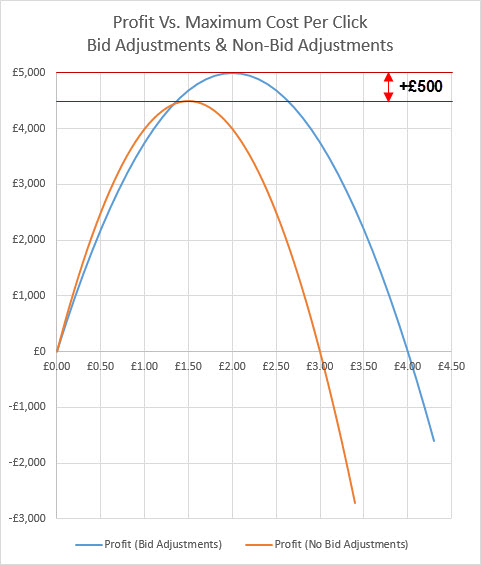 Little changes to a PPC account can have a great impact on overall profitability, the amount of revenue generated verses the amount spent.
Little changes to a PPC account can have a great impact on overall profitability, the amount of revenue generated verses the amount spent.
Below we will go over a few effective ways to optimise a PPC account by changing maximum cos-per-click bids in different ways…
Changing the maximum CPC bids directly
The most obvious way to optimise a PPC account is to tweak the maximum cost-per-click amounts, the most you are willing to spend per click from each target keyword.
Looking at the two extremes of maximum CPC bids:
- Low Max. CPC Bid = Very few clicks but very cheap clicks, leading to a high return on investment, but few sales overall
- High Max. CPC Bid = Very expensive clicks but many clicks overall, leading to a low return on investment, but many sales overall
The profitability of the advertising depends on two key factors, the overall sales revenue minus the costs from advertising. Below is a simulated graph showing how the profit is effected by shifting the Max. CPC higher and lower:
You can see that the ads don’t get much exposure with a low Max. CPC bid and don’t produce much profit overall due to the small number of sales. When the Max. CPC bid is raised much higher the advertising costs out-weight the revenue generated from all the sales made and again overall profits are lowered.
To fully optimise a keyword the sweet spot should be aimed for in the middle where the profits are highest, this will involve experimenting with higher and lower bids to get enough bid adjustment data and looking deeply into ecommerce Analytics statistics. Surprisingly you can see that sometimes lowering higher Max. CPC bid amounts can generate more profits, even though overall sales will be lowered.
In reality the graph above would only be semi-complete with several limiting factors when the Max. CPC value is changed such as:
- Relatively small Max. CPC bids may place the advert off the first few pages of results and may never receive any clicks
- Relatively high Max. CPC bids may place the ad in position 1.0, from here you cannot gain any extra traffic by raising the Max. CPC bids as you are already in the most prominent spot
- A limited daily budget on a campaign may stiffen the number of clicks you could receive each day if Max. CPC’s were raised above a certain point (ads won’t be shown 100% of the time to hit daily budget targets)
Also please take note that competition changes all of the time, Google often changes the layout of the SERPs and you may have to raise bids by several pence to place your ad in a new position. This isn’t an exact science but a Max CPC. change of plus or minus £0.20 say might make a big difference to the bottom line.
Enhanced campaign bid adjustments
Google Adwords and Bing Ads allow you to adjust Max. CPC bid amounts for different locations, times of the week and/or device types for standard PPC advertising. You can quickly use these bid adjustments to turn different demographics on and off, for example to only show an advert on mobile devices or to only show an advert to people who live in London. Even better is the ability to adjust bid amounts slightly for different demographics, for example an ecommerce site may not be optimised for smartphone devices but it can still sell to some people on their smartphones, just at a reduced rate which can be accounted for.
Many ecommerce sites see different conversion rates from different parts of the country, let’s look into how we can adjust bids for different countries within the UK from some real data:
In this example England has a higher conversion rate and a higher average order value that the rest of the UK so I will be basing the bid adjustments from England’s percentages:
Setting the different locations to have these bid adjustments will optimise the account, rather than have one standard Max CPC. for the whole of the UK lumped together.
How enhanced campaign bid adjustments can make a difference in profits
You may be wondering why you would want to reduce the bid amounts for certain locations, devices or times, surely it would just reduce the number of sales you could possibly make? This would be true if the Max. CPC’s weren’t raised afterwards, especially if the account was around it’s target return-on-investment (revenue over costs) level beforehand.
Using bid adjustments allows you to spend extra on more profitable traffic and spend less on the less profitable traffic, thus maintaining the same ROI whilst increasing overall profits with extra sales.
Basically without bid adjustments money will be wasted on worst times, locations and/or devices and this wasted money will bring all the averages down. As many retailers have a set ROI, the better performing times, locations and/or devices are dragged back when they could be promoted further still maintaining the same ROI.
This simulated graph has the same rules for both bidding strategies, the amount of traffic received with different bid amounts. In this example traffic performs at a 2% conversion rate for one period and a 4% conversion rate for another period so the bid adjustment is -50% for the lower performing period giving these results.
You can see that at lower Max CPC. bids more profit is made early on by the non-bid adjusted campaign as no budget is being held back. Close to where the non-bid adjusted account hits it’s peak the bid adjusted account exceeds it, in this case by £500 extra profit, with much higher bid amounts winning extra traffic/sales.
Conclusion
With a lot of data and a few simple calculations you can tweak a PPC account to make it much more profitable overall.
You can tweak the Maximum Cost-per-click amount to get the right balance between the number of sales and the advertising cost of each sale. You can also apply bid adjustments to separate out any good or bad traffic and bid accordingly towards each group increasing sales without decreasing return-on-investment levels.






